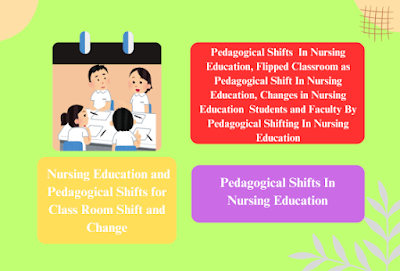The Pedagogical Shifts for Class Room Shift and Change In Nursing Education. This includes the use of technology, the integration of collaborative learning, and a focus on competency-based learning alongside theoretical knowledge.
The Pedagogical Shifts for Class Room Shift and Change In Nursing Education
Pedagogical changes in nursing education, particularly those related to changes in classroom teaching and online learning, emphasize the transition from traditional lecture-based methods to more interactive and student-centered approaches. The overarching principle of the five major pedagogical approaches, namely, constructivist, collaborative, integrative, reflective, and inquiry based learning, is constructivism, which is in nature, active and student-centered. This paper focuses on the reflective pedagogical approach (Chan & Lee, 2021).
In the context of this research study, pedagogical change is defined as a process in which faculty members work together to transform their currently isolated teaching methods into collaborative teaching by integrating web-based communication technologies into the new teaching methods.
Change in Nursing Education Understanding Pedagogical Shifts in Nursing Education
The landscape of nursing education is evolving, driven by advancements in technology and a shift in pedagogical approaches. Two significant changes are reshaping how nursing faculty teach: the transition from traditional teaching methods to a learning-focused approach and the adoption of the flipped classroom model.
From Teaching to Learning: A Paradigm Shift
Traditionally, nursing education followed a “sage on the stage” model, where the instructor delivered lectures while students passively received information. Today, there’s a shift towards a “guide on the side” approach. This new model emphasizes interactive learning, where faculty members facilitate rather than dictate the learning process.
Technological innovations have played a crucial role in this transition. Tools such as electronic case histories and concept maps enhance interactive pedagogy, allowing instructors to act as facilitators, coaches, and guides. This approach encourages active engagement and deeper understanding of the material (Shellenbarger & Robb, 2014). For additional strategies on promoting engaged learning, refer to Chapter 15.
The Flipped Classroom Model
The flipped classroom represents a transformative pedagogical shift in nursing education. This model inverts the traditional teaching structure by delivering lecture content outside of class, usually through videos or readings. Classroom time is then dedicated to applying knowledge through interactive activities and receiving feedback.
- Preparatory Work: Students access lectures, readings, and quizzes before attending class. This preparation allows them to engage in practical activities during class time (Hawks, 2014).
- Classroom Activities: Instructors facilitate discussions and hands-on exercises that reinforce and apply the preparatory material. This active learning approach helps students meet specific learning outcomes (Hamdan et al., 2013).
- Technology Integration: The success of a flipped classroom depends on both students’ commitment to pre-class preparation and faculty’s ability to utilize technology effectively. Faculty must create and distribute digital content, such as videocasts and podcasts, and use classroom tools like wikis and presentation software to support interactive learning (Schlairet et al., 2014; Silverthorn, 2006).
- Learning Analytics: Advanced tools, including learning management systems (LMS) and audience response systems (ARS), play a crucial role in the flipped classroom. These technologies help track student progress, identify areas needing improvement, and adjust instructional strategies accordingly (Bull, 2013).
Research indicates that while the flipped classroom can enhance learning outcomes, it also requires significant preparation and technology support (Schlairet et al., 2014; Schwartz, 2014). Studies show mixed student satisfaction with this model, highlighting the need for careful implementation (Critz & Knight, 2013; Missildine et al., 2013).
Impact of Pedagogical Shifts on Students and Faculty
The integration of digital technology into nursing education has significantly impacted both students and faculty.
- Digital Natives: Today’s nursing students, often referred to as digital natives, are accustomed to instant access to information and expect immediate feedback (Watson & Pecchioni, 2011). They are generally more comfortable with technology than faculty, who may be less familiar with digital tools.
- Technology Use in Class: Despite owning multiple digital devices, many students find limited use of these tools in their classes. Research suggests a gap between students’ technology skills and their application in the classroom (Dahlstrom et al., 2013; Wilkinson et al., 2013).
- Curriculum Integration: Although computer literacy, information literacy, and nursing informatics are increasingly incorporated into curricula, integration remains slow (Button et al., 2013). Faculty must adapt to these changes, learning to use technology effectively and integrating it meaningfully into their teaching.
- Faculty Adaptation: For effective implementation, faculty need to embrace new technologies and learn to use them to achieve educational goals. This may involve seeking support from technology experts, attending relevant conferences, and utilizing available technological resources (National Council of State Boards of Nursing, 2011).
In conclusion, the shift towards a learning-focused approach and the adoption of the flipped classroom model represent significant changes in nursing education. These pedagogical innovations require both students and faculty to adapt to new ways of teaching and learning, leveraging technology to enhance educational outcomes and engagement.
Read More:
https://nurseseducator.com/didactic-and-dialectic-teaching-rationale-for-team-based-learning/
https://nurseseducator.com/high-fidelity-simulation-use-in-nursing-education/
First NCLEX Exam Center In Pakistan From Lahore (Mall of Lahore) to the Global Nursing
Categories of Journals: W, X, Y and Z Category Journal In Nursing Education
AI in Healthcare Content Creation: A Double-Edged Sword and Scary
Social Links:
https://www.facebook.com/nurseseducator/
https://www.instagram.com/nurseseducator/
https://www.pinterest.com/NursesEducator/
https://www.linkedin.com/in/nurseseducator/
https://www.researchgate.net/profile/Afza-Lal-Din
https://scholar.google.com/citations?hl=en&user=F0XY9vQAAAAJ

Thanks , I have recently been looking for information approximately this subject for ages and yours is the best I have found out so far. However, what concerning the bottom line? Are you sure in regards to the source?